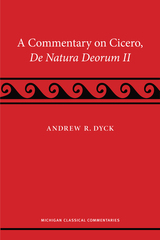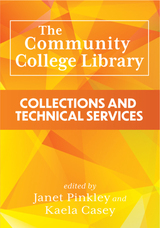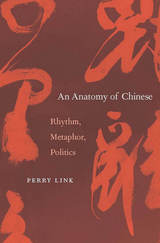
During the Cultural Revolution, Mao exhorted the Chinese people to “smash the four olds”: old customs, old culture, old habits, and old ideas. Yet when the Red Guards in Tiananmen Square chanted “We want to see Chairman Mao,” they unknowingly used a classical rhythm that dates back to the Han period and is the very embodiment of the four olds. An Anatomy of Chinese reveals how rhythms, conceptual metaphors, and political language convey time-honored meanings of which Chinese speakers themselves may not be consciously aware, and contributes to the ongoing debate over whether language shapes thought, or vice versa.
Perry Link’s inquiry into the workings of Chinese reveals convergences and divergences with English, most strikingly in the area of conceptual metaphor. Different spatial metaphors for consciousness, for instance, mean that English speakers wake up while speakers of Chinese wake across. Other underlying metaphors in the two languages are similar, lending support to theories that locate the origins of language in the brain. The distinction between daily-life language and official language has been unusually significant in contemporary China, and Link explores how ordinary citizens learn to play language games, artfully wielding officialese to advance their interests or defend themselves from others.
Particularly provocative is Link’s consideration of how Indo-European languages, with their preference for abstract nouns, generate philosophical puzzles that Chinese, with its preference for verbs, avoids. The mind-body problem that has plagued Western culture may be fundamentally less problematic for speakers of Chinese.
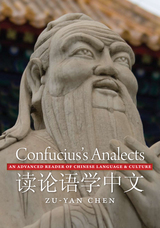
Confucius’s Analects is an innovative textbook for teaching and learning Chinese language and culture at the advanced level. It combines classical and modern Chinese language skills, Chinese culture, and expository and narrative writing practice.
Confucius's Analects is a central work of East Asian intellectual history that permeates Chinese and East Asian thought and values today. Students seeking to develop advanced language proficiency need to be familiar with the Analects in order to understand the wealth of literary allusions that appear in modern as well as classical Chinese writings. A selection of 82 passages, which are all educational and practical for present-day students, are grouped thematically into four parts—knowledge, morality, wisdom, and government—and covers Confucian teachings from personal cultivation to social contribution.
Features:• A quadrupled text system includes quotations from the Analects, modern Chinese translations of these passages, short essays of exegesis that elaborate on the major points, and historical Chinese stories that illustrate the theme• Vocabulary expansion sections show how monosyllabic classical words have each expanded into ten selected modern bisyllabic words• Almost 300 idioms and corresponding exercises teach their rhetorical value and provide cultural exposure• Sections on function words help students to understand classical Chinese• Extensive writing practice in each chapter includes debate, composition, storytelling, and topical research—all requiring internet research• Audio files of recitation of the Analects passages by a native speaker are available online for free
Designed for students who have studied Chinese for three years in college or an equivalent, this textbook is ideal for students of advanced Chinese, classical Chinese, and Chinese culture. Knowledge of classical Chinese is not a prerequisite.

Cultural Chinese: Readings in Art, Literature, and History is an advanced language textbook with a new approach to cultural integration and immersion. In this unique book, culture becomes the very core of language learning, transitioning its role from context to text.
This textbook is ideal for courses in advanced Chinese and Chinese culture. Third- and fourth-year students and instructors will find themselves deeply immersed in the very fabric of Chinese culture that governs personal behavior and directs social dynamics.
FEATURES:
• Each of nine lessons features a distinctive topic of Chinese culture that serves as a portal to Chinese perceptions and perspectives.
• Main text of each lesson begins with a brief introduction and is further illustrated with two historical or mythological stories that inform Chinese values and attitudes.
• Additional mini-stories challenge students’ abilities of cultural interpretation.
• Includes a total of twenty-seven stories familiar to every educated Chinese person that will prepare students for meaningful communication and understanding.
• Each lesson includes more than ten sections of exercises intertwined with culture, including vocabulary and idioms, historical information, linguistic points, translation exercises, and online research required for debate, composition, and storytelling.
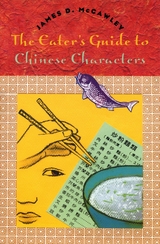
With this guide in hand, English speakers hold the key to a world of tantalizing—and otherwise unavailable—Chinese dishes.
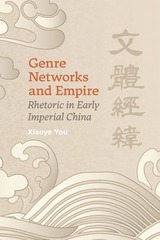
In Genre Networks and Empire, Xiaoye You integrates a decolonial and transnational approach to construct a rhetorical history of early imperial China. You centers ancient Chinese rhetoric by focusing on how an imperial matrix of power was established in the Han Dynasty through genres of rhetoric and their embodied circulation, and through epistemic constructs such as the Way, heaven, ritual, and yin-yang.
Through the concept of genre networks, derived from both ancient Chinese and Western scholarship, You unlocks the mechanisms of early Chinese imperial bureaucracy and maps their far-reaching influence. He considers the communication of governance, political issues, court consultations, and the regulation of the inner quarters of empire. He closely reads debates among government officials, providing insight into their efforts to govern and legitimize the regime and their embodiment of different schools of thought. Genre Networks and Empire embraces a variety of rhetorical forms, from edicts, exam essays, and commentaries to instruction manuals and memorials. It captures a range of literary styles serving the rhetorical purposes of praise and criticism. In the context of court documentation, these genre networks reflect systems of words in motion, mediated governmental decisions and acts, and forms of governmental logic, strategy, and reason.
A committed work of decolonial scholarship, Genre Networks and Empire shows, through Chinese words and writing, how the ruling elites of Han China forged a linguistic matrix of power, a book that bears implications for studies of rhetoric and empire in general.
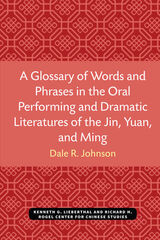


This textbook for beginning students contains 35 lessons of increasing difficulty designed to introduce students to the basic patterns of Classical Chinese and to provide practice in reading a variety of texts. The lessons are structured to encourage students to do more work with dictionaries and other references as they progress through the book.
The Introduction provides an overview of the grammar of Literary Chinese. Part I presents eight lessons on sentence structure, parts of speech, verbs, and negatives. Part II consists of sixteen intermediate-level lessons, and Part III offers five advanced-level selections. Part IV has six lessons based on Tang and Song dynasty prose and poetry.

The second edition of An Introduction to Literary Chinese incorporates recent developments in linguistics and has been expanded to include a lesson on Buddhist texts. Beginning with an overview of literary Chinese—its phonology, morphology, and syntax, as well as a short account of the nature of the writing system—the textbook then presents thirty-six lessons of increasing difficulty designed to introduce students to the basic patterns of the language and give them practice in reading a variety of texts.
Part I presents eight lessons on the basic syntactic components in literary Chinese. Each lesson begins with an overview of its topic, introduces an exemplary text, and provides a glossary, notes, and practice exercises. The sixteen lessons in Part II use increasingly long and complex texts to introduce styles of narrative and argumentation in literary Chinese and, at the same time, solidify students’ grasp of the syntax. The advanced texts in the six lessons in Part III introduce students to central authors and philosophical traditions in premodern China and broaden the process of reading to include elements of cultural and historical interpretation. Part IV has six lessons comprising important Tang and Song dynasty prose and poetic texts.

Among the world’s languages, Vietnamese provides unique insight into the cosmopolitan dynamism of premodern Asia. Modern notions of language history are often constrained by nationalist narratives, focused on bolstering a particular nation’s social, cultural, or political identities. A closer look at the Vietnamese language reveals a rich record of interaction and transformation that does not fit easily within modern nation-state lines or boundaries.
By employing philological, textual, and comparative linguistic methodologies, John D. Phan uncovers the history of a Sinitic language rooted in the Red River Plain of northern Vietnam, which he calls “Annamese Middle Chinese.” The life and death of this language stimulated dramatic transformations in the speech of the region, ultimately giving rise to a new and alloyed language over the early centuries of the second millennium—Vietnamese.
Drawing connections among linguistic, demographic, intellectual, and cultural realities over time, Phan traces the story of the emergence of Vietnamese within the broader context of a cosmopolitan East and Southeast Asia. Lost Tongues of the Red River demonstrates how language forms a surprisingly intimate record of human interaction—one with unique potential to enrich and expand our understanding of the distant past.
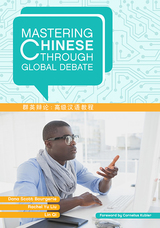
While language instructors recognize the value of debate as a means of facilitating Advanced- and Superior-level skills, no single advanced Chinese textbook exists that provides level-specific scaffolded language exercises, rhetorical strategies, and topic-specific texts within the context of debate. Mastering Chinese through Global Debate, designed to meet the ACTFL proficiency guidelines and featuring content written by a professional Chinese journalist, offers learners the means to develop sophisticated language skills with the goal of achieving Superior-level proficiency.
The textbook provides sets of readings and exercises that culminate in debates on key cultural topics with fellow students at home and/or with native speakers abroad via teleconference technology. Each of the six chapters includes detailed explanations, idea maps, word banks, writing and speaking samples, varied drills, and a rhetorical methods section—all of which foster language and critical thinking skills and prepare students to analyze and debate on complex topics.
The textbook’s audio companion is available at press.georgetown.edu and includes MP3 files of the feature article and a mock debate in each chapter, as well as transcripts of the audio, encouraging students to both listen and read. Instructors can also access a free answer key on the Georgetown University Press website.

Forty lessons designed to introduce beginning students to the basic patterns and structures of Classical Chinese are taken from a number of pre-Han and Han texts selected to give students a grounding in exemplary Classical Chinese style. Two additional lessons use texts from later periods to help students appreciate the changes in written Chinese over the centuries.
Each lesson consists of a text, a vocabulary list featuring discussions of meaning and usage, explanations of grammar, and explications of difficult passages. The standard modern Chinese, Japanese, and Korean pronunciations are indicated for each character, making this a learning tool for native speakers of those languages as well.
Appendices give suggestions for further readings, review common and significant words, explain the radical system, and provide Japanese kanbun readings for all the selections. Glossaries of all vocabulary items and pronunciation indexes for modern Chinese and Korean are also included.
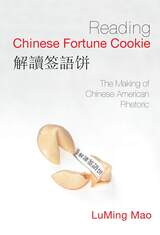
ecent scholarship tends to explain such influences as contributing to language hybridity---an advance over the traditional "deficit model." But Mao suggests that the "hybridity" approach is perhaps too arid or sanitized, missing rich nuances of mutual exchange, resistance, or even subversion. Through his concept of "togetherness in difference, Mao suggests that speakers of hybrid discourse may not be attempting the standard (and failing), but instead may be deliberately importing cultural material to create a distance between themselves and the standard. This practice, over time, becomes a process that transforms English, enriching and enlarging it through the infusion of non-Western discourse features, subverting power structures, and even providing unique humorous touches.
Of interest to scholars in composition, cultural studies, and linguistics as well, Reading Chinese Fortune Cookie leads in an important new direction for both our understanding and our teaching of English.
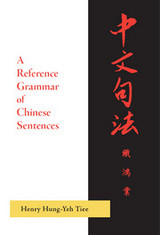
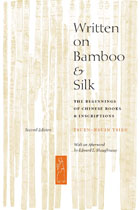
READERS
Browse our collection.
PUBLISHERS
See BiblioVault's publisher services.
STUDENT SERVICES
Files for college accessibility offices.
UChicago Accessibility Resources
home | accessibility | search | about | contact us
BiblioVault ® 2001 - 2025
The University of Chicago Press


